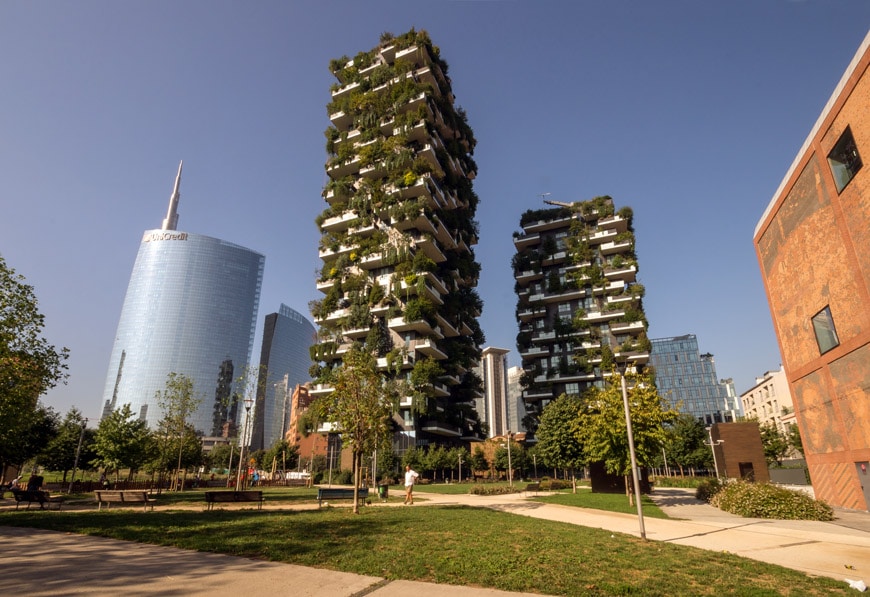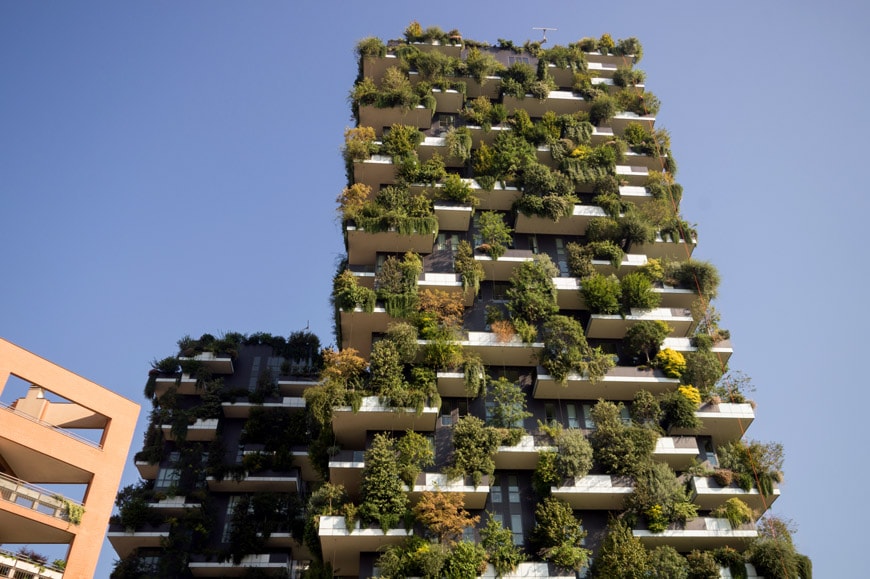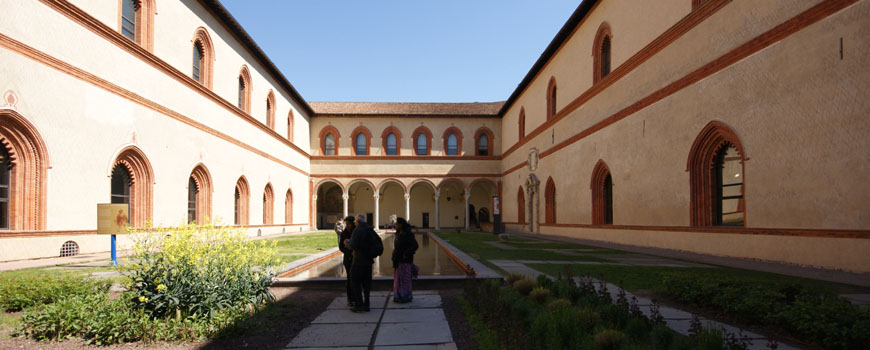Stefano Boeri’s Vertical Forest. From Hype to Archetype?
The Bosco Verticale / Vertical Forest high-rise complex in Milan, view from the Porta Nuova Gardens looking west. Photo © Riccardo Bianchini / Inexhibit
The Vertical Forest Towers in Milan by Boeri Studio. From Hype to Archetype?
In recent times, the “Vertical Forest” (Bosco Verticale in Italian) designed by Boeri Studio (Stefano Boeri, Gianandrea Barreca, and Giovanni La Varra) has been one of the most discussed architectural designs, both in Italy and internationally.
Vertical Forest is a residential complex consisting of two towers, 110 and 76 meters high (160 and 250 feet), completed in 2014 in Milan’s Porta Nuova district. The most interesting aspect of a project that – for its visually striking aspect – is possibly the most famous among the many realized in Milan in the last years – is that Vertical Forest is a sort of “pilot project” of a new generation of sustainable buildings.
Many articles, some laudatory some critical, have been written about the “Forest”; yet, only a few of them analyze the key point of this project; namely, if the idea to “hybridize” a high-rise building and woodland does make sense, from an architectural, urban, ecological and technical point of view. This requires getting rid of apologies and polemics, as well as ignoring opinions based only on aesthetic or superficial socioeconomic discussions. Furthermore, it asks us to be more investigators of possible futures than architectural critics.
The idea
The principles upon which the Vertical Forest project is based are something I agree with, admittedly.
After so many years in which form has been the main, if not the only, element to care about in architecture, Boeri focused instead on urban people’s needs, and the role of building design within an urban strategy, and tries to push contemporary architecture beyond the ordinary.
“Vertical Forest is a model for a sustainable residential building, a project for metropolitan reforestation contributing to the regeneration of the environment and urban biodiversity without the implication of expanding the city upon the territory. It is a model of vertical densification of nature within the city (…). On flat land, each Vertical Forest equals, in the number of trees, an area of 20,000 square meters of forest. In terms of urban densification, it is the equivalent of an area of a single-family dwelling of nearly 75,000 square meters. The vegetal system of the Vertical Forest contributes to the construction of a microclimate, produces humidity, absorbs CO2 and dust particles and produces oxygen.
Vertical Forest increases biodiversity. It helps to set up an urban ecosystem where a different kind of vegetation creates a vertical environment that can also be colonized by birds and insects and therefore becomes both a magnet for and a symbol of the spontaneous re-colonization of the city by vegetation and by animal life. The creation of several Vertical Forests in the city can set up a network of environmental corridors that will give life to the main parks in the city, bringing together the green space of avenues and gardens and interweaving various spaces of spontaneous vegetation growth. (…)
Vertical Forest is an anti-sprawl measure that aims to control and reduce urban expansion. If we think of them in terms of urban densification, each tower of the Vertical Forest is equivalent to an area of the urban sprawl of family houses and buildings of up to 50,000 square meters.”
From the project description by Boeri Studio
A lot to get through, someone may say; an ambitious project aimed to reshape Le Corbusier’s Ville Radieuse on 21st-century paradigms. Truly ambitious, but also plausible? Is Milan’s Vertical Forest a model? Is it the first individual of a new species or just a sterile branch of architectural evolution?
East facades of the Vertical Forest towers. Photo © Riccardo Bianchini / Inexhibit
How Vertical Forest is made
From an architectural point of view, the two towers are relatively traditional buildings. They have a reinforced concrete structural frame with 28-centimeter / 11-inch thick floor slabs. The facades, clad in dark-gray porcelain tiles, are marked by a sequence of large balconies, 3.35 meters / 11 feet deep, which make the building looks quite dynamic.
The complex has a total gross floor area of 40.000 square meters / 430.000 square feet divided between the southern tower, called Torre de Castilla, and the western one, the Torre Confalonieri. The Vertical Forest apartments are notoriously expensive and aimed at a wealthy clientele. Two well-designed buildings, in the typical sober style of Milanese architecture, but nothing particularly innovative, per se.
Indeed, it’s their vegetation that makes the two towers interesting – architecturally, conceptually, and technically – the rest doesn’t matter much.
In detail, the large balconies accommodate an ensemble of plants of over one hundred different species.
800 trees from 3 to 9 meters / 10 to 30 feet high, including holm oaks (Quercus Ilex), downy oaks (Quercus pubescens), golden rain trees (Koelreuteria paniculata), wild pears (Pyrus pyraster), manna ashes (Fraxinus ornus), beeches (Fagus sylvatica), apple trees (Malus x ‘Red Jewel’), Higan cherries (Prunus subhirtella), olive trees (Olea europaea sylvestris), Turkish hazels (Corylus colurna), and Persian ironwood (Parrotia persica), among others.
4.500 shrubs, including hazels, strawberry trees, hawthorns, brooms, Saint John’s Worts, purple osiers, and jasmines.
15.000 ornamental plants
Apart from their aspect, the different plant species were selected and positioned depending on the facade exposition, as well as on the required level of sun-shading of each dwelling unit. The plants were installed into concrete containers with different dimensions, depending on the type of plant. Trees were planted on a 1-meter-thick soil layer, while shrubs were planted on a 50-centimeter-thick one. A water-draining and root-resistant system, composed of Polyethylene and geotextile fabric layers, was positioned between the soil and the internal waterproofing membrane of each container.
The first technical problems the architects had to cope with were the static and dynamic loads induced by the trees and by the effects of the wind on them. This implies simulating their effects in a wind tunnel and introducing technical elements, such as special steel anchors and security cables which retain the trees and avoid broken branches from falling from the towers.
To solve the issues related to plant irrigation and maintenance, the design team developed several ingenious solutions. The plants are watered by a complex centralized system divided into sub-sectors and equipped with compensated drippers that filter and reuse gray water from the buildings and recycle the groundwater utilized by the geothermal heat-pump-based VAC system of the complex. The maintenance of the vegetation is “facilitated” by two cranes installed on top of the towers, which allow the gardening staff to operate on the plants from the outside. In Milan, the towers’ vertical forest is a shared garden; therefore, its maintenance is managed by the condo administration and not by each resident individually.
The Vertical Forest towers in Milan, view from the south. Photo © Riccardo Bianchini / Inexhibit
Is Milan’s Vertical Forest a replicable model?
This is an architecture that is hard to ignore; furthermore, its architects consider it as the first example of a new architectural species, a “model” that might potentially change our cities’ shape, and our lifestyle, forever.
Yet, whether the Vertical Forest of Milan, which is going to be replicated in other cities in Europe and Asia, will be an archetype or not depends on some conditions.
The vegetation of the Vertical Garden can complement public green space but should not replace it because the morphology and costs of installation and maintenance of vertical gardens are arguably very unfavorable if compared to those of “traditional” urban green areas. Consequently, a wise urban strategy could promote vertical foresting on buildings, for example through tax exemption, but only when enough ground-planted public green spaces and community gardens have been created and made available to all citizens.
The trees that make Vertical Forest different from a building with a traditional green facade or balcony gardens should be carefully studied, and their growth and long-term conditions further investigated to understand what species better fit a so diverse set of environmental conditions. Does the vegetation be just decorative or it can also feature edible plants and fruit trees? To date, trees are grown full size in a nursery and then moved onto the facades of the towers, how long those trees will live, and what their development will be in a so “artificial” environment? It is too early to draw a conclusion on that, to date.
We must understand the maintenance problem better. Who must get it? The condo as a whole? Each resident? The local municipality? This depends also on who is the owner of the “forest”. In Milan, it is all condo as a whole who is responsible for maintenance, which assures reliable maintenance procedures and a correct choice of plant species compatible with the environmental conditions; yet, it also implies high maintenance cost for the inhabitants of the complex. Is that the best strategy possible?
Will the construction and maintenance extra costs of “Vertical Forest buildings” be compensated by the reduction in energy consumption and the more favorable impact on the urban environment that they may produce? Along with the effect on people’s physical and psychological comfort, this depends on the actual influence of such buildings on things such as the quality of air in the urban environment, pollution reduction, and mitigation of the heat island effect. Sustainable irrigation strategies, for example through intensive use of rainwater, are also to be studied thoroughly.
Can Milan’s Vertical Forest be applied also to non-luxury residential developments? To date, the exclusive purchase prices and maintenance costs of the Milanese complex make it attractive only to a wealthy clientele. A social housing version of Boeri’s building, currently under development in Eindhoven, will possibly give some answers to this question.
Finally, we have to understand if sustainable urban densification and effective solutions against urban sprawl are better achieved through the model of “vegetalized” high-rise towers or 5-6-story residential buildings with green facades and roof gardens; or, maybe, with both of them.
Photos above © Riccardo Bianchini / Inexhibit
copyright Inexhibit 2024 - ISSN: 2283-5474







